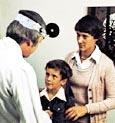
MYRINGOTOMY AND TUBES
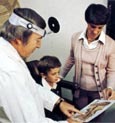
This webpage is designed to provide some information concerning the myringotomy operation, the insertion of a ventilation tube into the middle ear cavity, and the medical condition your physician has discovered which makes these procedures advisable.
Note: The information contained on this webpage is not meant to be used as a substitute for the advice of a medical doctor. Only a physician can diagnose the specific medical problem of an individual and recommend a method of treatment.
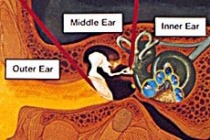
The hearing mechanism can be divided into sections. The first is the Outer Ear. It includes the part of the ear which you see plus a short canal ending with the eardrum.
Next is the Middle Ear which contains a chain of three small bones. A small passage called the Eustachian tube leads from the Middle Ear cavity to the back of the throat.
The third section of the ear is the Inner Ear where the nerve center of hearing, or Cochlea, is located.
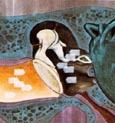
Normally, the Middle Ear is filled with air. This is necessary for the general good health of the ear and for the mechanism itself to work properly.
The air pressure in the Middle Ear should be equal to the air pressure on the outer side of the eardrum. The Eustachian tube helps maintain this balance of air pressure.
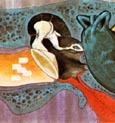
Allergies, a cold or other nose and throat infection might close the Eustachian tube, blocking the exchange of air.
As a result, a vacuum may develop in the Middle Ear cavity.
The air from the outside will push the eardrum inward as it tries to fill the vacuum. This causes a painful earache or a plugged ear feeling.
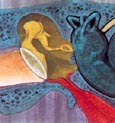
Eventually, the vacuum will pull fluid from the lining of the Middle Ear.
As the fluid fills the cavity, it eliminates the vacuum and the earache might disappear for a time. However, hearing becomes less acute as the fluid builds up, and pain may return as the fluid pressure increases.
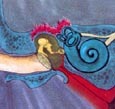
The fluid, which is like water at first, may get as thick and sticky as glue if the ear is not treated.
Also, infection could spread to the Mastoid bone and, eventually, might involve the inner ear.
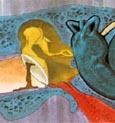
The fluid build-up can also cause the eardrum to break open. That breakage relieves the pressure, which may relieve the pain.
However, hearing is impaired and drainage may be a continuing problem. There is also the danger of tissue growing into a potentially dangerous false tumor called a Colesteatoma.
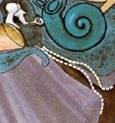
Children tend to develop Middle Ear infections more often than adults.
Children are more susceptible because a child’s Eustachian tube is straighter and shorter than an adult’s. This provides easier access for infection-causing bacteria.
If the infection does not respond to antibiotics, a doctor may decide to perform a minor surgical operation.
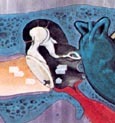
In the operation, a tiny incision called a myringotomy is made in the eardrum. Sometimes a small ventilating tube is inserted.
The tube allows a free exchange of air between the Outer Ear and Middle Ear, and effectively replaces the function of the Eustachian tube until it can resume normal operation.
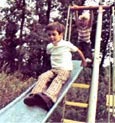
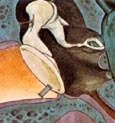
The tube may have to be removed if it stays in too long, but normally it works its way out into the canal of the Outer Ear during the hearing process.
If there is no reinfection; the Middle Ear, Eustachian tube and hearing mechanism will return to normal or near normal.
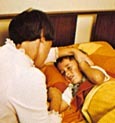
Be on the alert for any change in hearing or draining from the ear. Medical attention is required in either case.
Should the ear become infected again, or if fluid should recur and fill the cavity, another tube may have to be inserted.
In any event, an ear infection should never be neglected since it can lead to serious consequences.
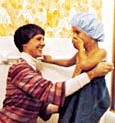
There are some special post-operative precautions that should be taken at home when a person has had a ventilating tube put in the eardrum:
- Water should be kept out of the ear as long as the tube is in place.
- Avoid undue fatigue, as it might predispose to a cold.
- If you sneeze, do so with your mouth open.
- Do not blow your nose, instead, you should draw the mucus into the mouth and “spit out.”
- Be alert for new ear infections and/or draining fluid — medical attention is necessary if either of these conditions occur.
